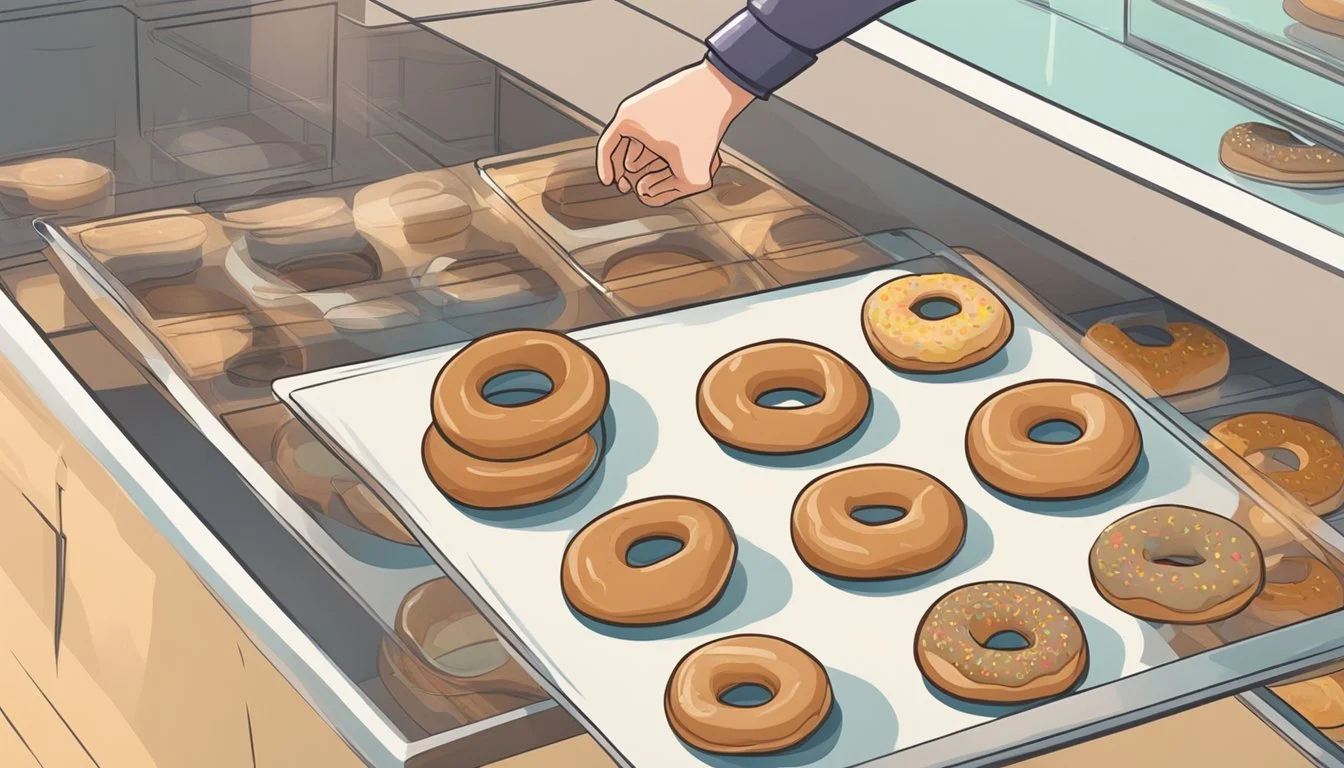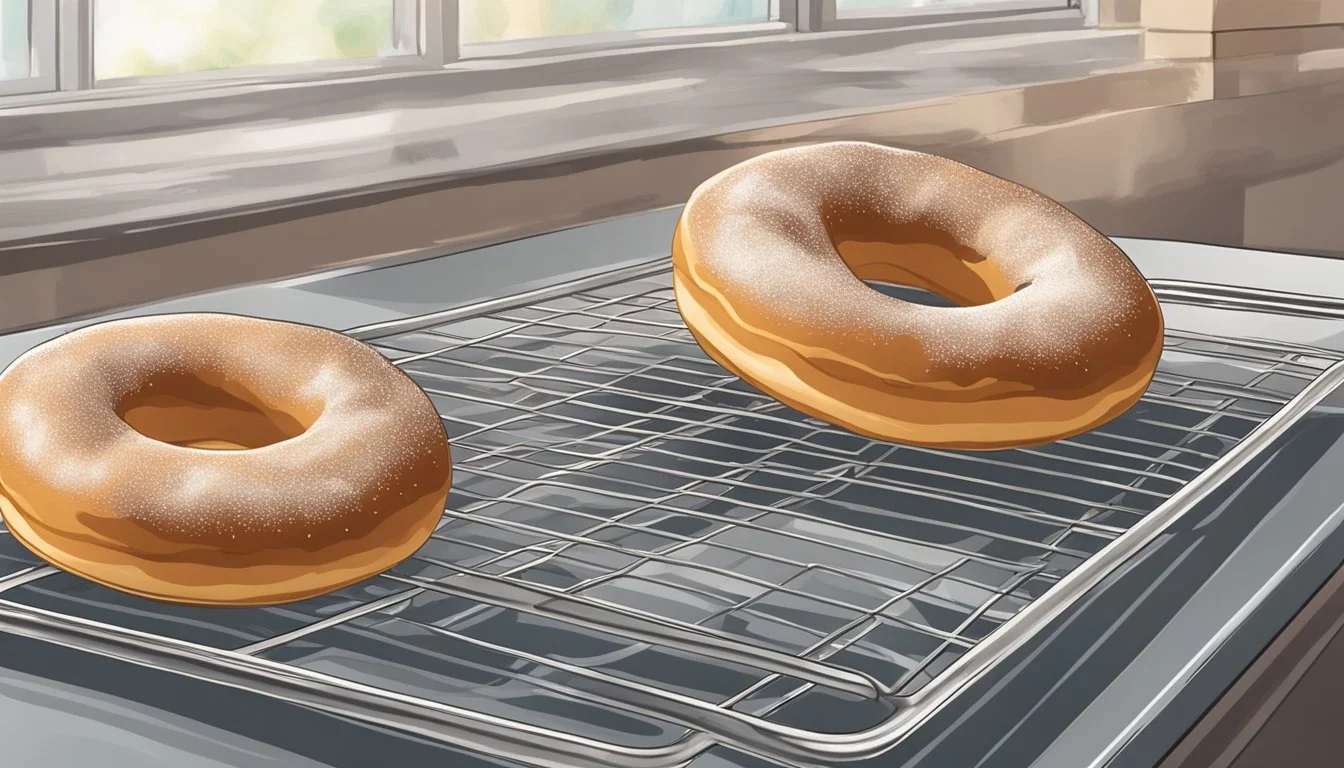How to Freeze Homemade Doughnuts
A Guide to Preserving Your Sweet Treats
Freezing homemade doughnuts effectively preserves their freshness and flavor for future enjoyment. It is a straightforward process that requires minimal equipment and time. The key to successfully freezing doughnuts is to minimize the exposure to air and to prevent the formation of ice crystals, which can degrade the texture and taste of the delicate pastry.
To prepare doughnuts for freezing, one should ensure that they are completely cooled to prevent condensation and ice crystal formation. A metal cookie sheet lined with wax or parchment paper can be used to spread out the doughnuts in a single layer, preventing them from sticking together. This step, commonly referred to as flash freezing, solidifies the icing and maintains the doughnut's shape.
Once the doughnuts are frozen solid, they can be transferred to airtight freezer-safe bags or containers. Removing as much air as possible from the bags before sealing them will further protect the doughnuts from freezer burn and extend their shelf life. Properly frozen doughnuts can be stored for several weeks, retaining their original taste and texture when properly thawed.
Understanding Donuts
Before diving into the specifics of freezing homemade donuts, it's important to recognize the variety of donuts available and the quality factors that affect their freeze-thaw cycle.
Types of Donuts
Donuts come in a multitude of styles, each with distinct characteristics:
Glazed Donuts: These are typically yeast-raised, light, and airy with a sweet, thin sugar glaze.
Sugar Donuts: Often coated in granulated or powdered sugar, they can be either cake- or yeast-based.
Plain Donuts: Without any glazing or sugar coating, these rely on the dough's flavor and are usually cake-style.
Specialty Donuts: This category includes brands like Krispy Kreme and encompasses various flavors, toppings, and styles, often known for their signature tastes.
The type of donut affects not only taste and texture but also how well it will withstand freezing and thawing processes.
Quality Considerations
When considering donut quality, focus on these key aspects:
Freshness: Fresh donuts, without signs of staling or drying out, freeze better.
Texture: Airy, yeast-raised donuts may freeze differently than denser, cake-style donuts.
Toppings and Fillings: Glazes, icings, and fillings need special attention as they can affect the freezing outcome.
For the best results, assess each donut's quality before freezing to ensure a delightful treat upon thawing.
Preparation for Freezing
When freezing homemade donuts, one's aim is to preserve freshness and prevent freezer burn. Proper packaging is crucial, as is a strategy to avoid moisture loss during long-term storage.
Packaging Donuts Properly
Materials Needed:
Plastic wrap
Wax paper or parchment paper
Aluminum foil (optional)
Freezer-safe bags or airtight containers
Steps:
Begin by allowing the donuts to cool to room temperature.
Wrap each donut individually in plastic wrap. For added protection, one can then wrap them in a layer of aluminum foil.
Place wrapped donuts on a baking sheet lined with wax paper, making sure they aren’t touching each other.
After the initial freeze on the baking sheet, transfer the donuts into freezer-safe bags or airtight containers.
Note: Layering wax paper between donuts in the container can prevent sticking.
Preventing Freezer Burn
Key Practices:
Remove as much air as possible from freezer bags prior to sealing.
Label the bags with the freezing date for future reference.
Consume frozen donuts within two months for optimal taste and quality.
By following these steps and best practices, one can successfully freeze donuts, maintaining their taste and texture for an extended time.
Freezing Process
When freezing doughnuts, ensuring they're wrapped properly and stored correctly is critical to maintain freshness and flavor.
Freezer Bag Method
For the Freezer Bag Method, an individual should place the doughnuts in a single layer on a baking sheet and put them in the freezer until they are frozen solid. Once firm, transfer the doughnuts to a freezer-safe bag, ensuring they have cooled completely to avoid condensation and ice crystals forming. It's crucial to remove as much air as possible from the bag to prevent freezer burn—using a straw to suck out air can be effective. Finally, label the bag with the current date before sealing and placing it back in the freezer.
Steps:
Place doughnuts on baking sheet.
Freeze until solid.
Transfer to freezer-safe bag.
Remove air and seal bag.
Label with date.
Aluminum Foil and Plastic Wrap Method
The Aluminum Foil and Plastic Wrap Method involves wrapping each doughnut individually first in plastic wrap and then in aluminum foil to provide a double layer of protection against freezer burn. Once the doughnuts have been tightly wrapped, they should be placed inside a freezer-safe container to shield them from any strong odors in the freezer. Labels are also important here; the container should have the date of freezing clearly marked. Doughnuts should remain in the freezer until required and can be expected to keep well for up to three months.
Steps:
Individually wrap doughnuts in plastic.
Add a layer of aluminum foil.
Put wrapped doughnuts in a container.
Label container with a date.
Defrosting and Reheating
When thawing and reheating frozen donuts, one must consider the methods that will best preserve their texture and flavor.
Thawing Frozen Donuts
Donuts should be defrosted at room temperature to ensure they retain their quality. Leaving them to thaw on the counter for a few hours is typically sufficient. To maintain moisture, one could also place the donuts in a microwave-safe container with a lid, using the defrost setting for 15 to 30 seconds. Handling them carefully prevents any icing or toppings from being damaged during the process.
Warming Up for Best Flavor
For the optimal experience, a warmed donut closely resembles the fresh, appealing texture and taste it had prior to freezing. Reheating them in an oven preheated to 350°F (175°C) on a baking tray lined with parchment paper for about 5 minutes is recommended. Alternatively, one could warm individual donuts in a microwave for 10-15 seconds on a high setting. This method requires monitoring to prevent the donuts from drying out or becoming too tough.
Storage Tips
When freezing homemade doughnuts, homeowners aim to preserve freshness and extend shelf life without sacrificing quality. Proper storage techniques can thwart freezer burn and flavor loss.
Maximizing Shelf Life
To considerably extend the shelf life of doughnuts, one must eliminate excess air from the storage container. Home bakers should wrap each doughnut individually in plastic wrap, ensuring a tight seal to prevent freezer burn. Placing the wrapped treats into freezer bags or airtight containers further enhances longevity. This method can keep doughnuts fresh for up to three months.
Individual Wrapping: Use plastic wrap to cover each doughnut completely.
Airtight Sealing: Place wrapped doughnuts into freezer bags, squeezing out air before sealing.
Efficient Use of Freezer Space
Efficiency in utilizing freezer space involves strategic placement and organization. Resealable freezer bags not only prevent the incursion of excess air but also flatten out, which contributes to a more organized freezer. For doughnuts, layering is key; placing a sheet of parchment paper between each doughnut within the bag prevents sticking.
Flat Storage: Resealable bags can be laid flat or stacked to save space.
Preventing Sticking: Insert parchment paper between doughnuts within bags.
Remember to label the container with the freezing date to keep track of freshness.
Additional Considerations
When freezing homemade doughnuts, it's essential to address icing and decorations properly, as well as how to deal with leftover doughnuts to maintain their quality.
Icing and Decorations
Freezing doughnuts with icing requires careful attention. If icing is too thin, it might absorb moisture and become soggy. For thick icing or glazes, ensure they are hardened before freezing. Items with powdered sugar should avoid moisture to prevent dissolving. Decorations like sprinkles should be secured to prevent them from falling off.
Storing Leftover Donuts
Leftover doughnuts can become stale if not stored correctly. They should be placed in an airtight container with the excess air removed to maintain freshness. For unfrosted doughnuts, consider wrapping them individually in plastic wrap before freezing. Stale donuts can also be refreshed by warming them in the microwave at 50% power for short intervals.
Frequently Asked Questions
Can homemade doughnuts be frozen successfully?
Yes, homemade doughnuts can be frozen effectively. They should be flash-frozen first to keep the quality intact and prevent sticking together.
What is the best method to freeze doughnuts?
The best option involves a step-by-step process:
Flash-Freezing:
Lay doughnuts on a wax paper-lined baking sheet.
Ensure they're spaced out to avoid touching.
Freeze until the doughnuts are solid, about 3-5 hours.
Wrapping:
Individually wrap each doughnut in plastic wrap or aluminum foil.
Storage:
Place wrapped doughnuts in a resealable freezer bag.
Remove excess air from the bag to minimize freezer burn.
Label the bag with the date of freezing.
How to defrost frozen doughnuts?
For optimal results, thaw them using one of two methods:
Microwave:
Set it to 50% power.
Heat the doughnut for 10-second intervals, checking softness.
Oven:
Preheat to 350 °F (176.66 °C).
Warm the doughnuts for a few minutes until they are thawed.
How long can you keep doughnuts in the freezer?
Doughnuts maintain their quality best within 1 month of freezing. They are safe to consume beyond that but may experience decline in quality over time.








